From October 4th to 6th, a delegation from the LIFE FOR SPECIES project, representing the University of Latvia's Institute of Biology and the Nature Conservation Agency, embarked on a valuable journey to Estonia for an exchange of expertise and networking. Representatives from the LIFE IP LatViaNature project also joined the delegation.
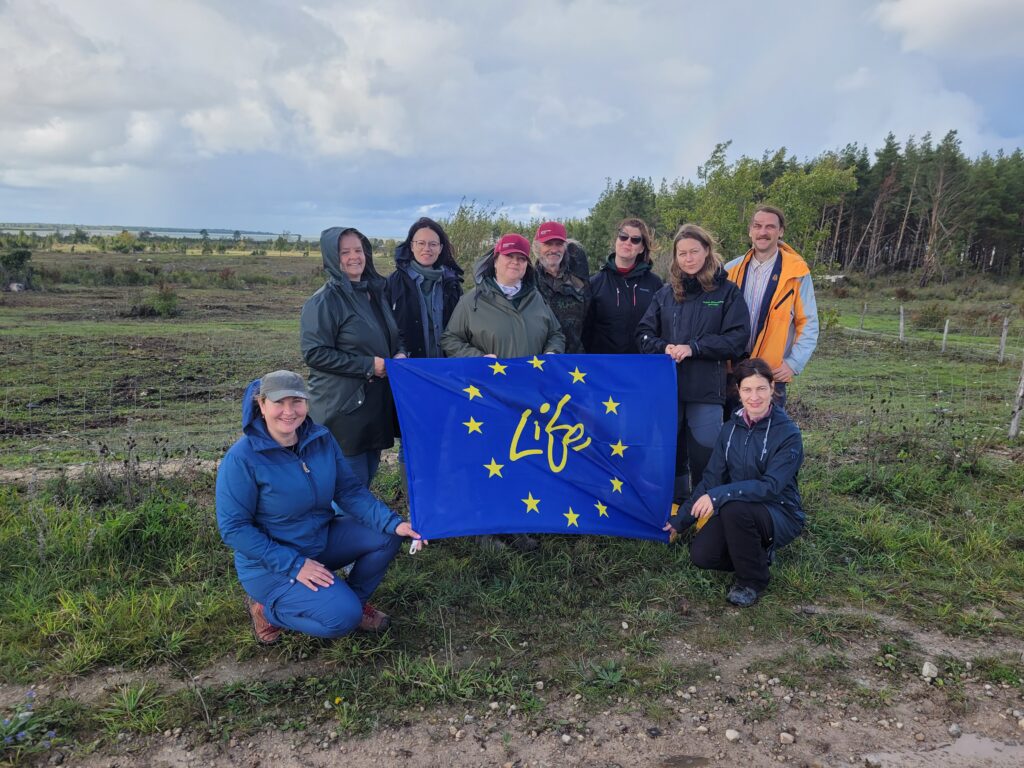
During this trip, the Latvian LIFE project teams delved into current issues and activities related to species and habitat conservation. They explored various initiatives aimed at restoring and monitoring different ecosystems in locations such as Muhu Island, Tartu, and the surrounding areas of Estonia, where several Estonian LIFE projects were actively engaged. Notably, they closely examined the ongoing restoration efforts of alvar grasslands on Muhu Island. These efforts were initiated under the LIFE+ nature project "Restoration of Estonian alvar grasslands" and are now continuing as part of the "LIFE connecting meadows" project. This restoration work involves creating park-like landscapes, restoring partially natural grasslands, coastal meadows, and reducing fragmentation in semi-natural landscapes. Various techniques, both technical and mechanical, along with controlled grazing, are employed to enhance conditions for preserving the genetic diversity of several species. The selection of habitats for restoration is based on a model developed within the GrassLIFE project, which identified the most valuable habitats requiring attention, many of which exist outside the Natura 2000 areas. Consequently, the activities observed on Muhu Island serve as an excellent example of the sustainability of results achieved across multiple LIFE projects.
The improvement of breeding habitats for amphibians is currently underway through the LIFE-IP ForEst&FarmLand project in Estonia. This project applies the best management practices established in previous LIFE Nature projects. Over the past decade or so, Estonia has witnessed a significant decline in amphibian populations, primarily due to intensified agriculture, the restoration of drainage systems, and the reduction of wetlands. To provide suitable breeding grounds for amphibians, historical habitats are being restored. This process involves draining or pumping out water initially, followed by excavating sediments down to the mineral (clay) layer. These water bodies are created in small clusters, typically consisting of 3 to 10 ponds, each varying in depth and strategically placed across different terrains to ensure water availability in at least some ponds during dry periods. Some of these ponds may remain dry during arid spells, reducing the populations of predatory aquatic insects and parasites.
Within the framework of the LIFE Mires Estonia project, substantial efforts have been invested in restoring the Soosaare bog, located within the Alam-Pedja nature reserve. Several years ago, approximately 120 hectares of this bog were drained for peat extraction during the Soviet era. Consequently, drainage ditches on the periphery of the territory have been blocked, gradually forming small pond complexes suitable for the breeding of moor frogs (Rana arvalis, R. temporaria). While the success of moor frog reproduction in these water bodies fluctuates from year to year, the overall results of these measures are considered successful. The ponds are being utilized, and the number of moor frog tadpoles has increased significantly, leading to a rise in the moor frog population. It is worth noting that moor frogs practically do not use the natural parts of the bog for breeding due to the physical and chemical properties of the water in the wet depressions and small ponds, which typically have a low pH. The diversity of newt species and the number of individuals have not significantly changed after bog restoration, including activities such as shrub and forest clearing, in the Soosaare bog. Automatic water level measurements and vegetation monitoring are also conducted using drones equipped with spectral sensors. However, the results of these observations regarding the success of bog restoration will only be interpretable several seasons after the implementation of these measures. Restoration efforts in the bog are ongoing, with monitoring of several species and habitats currently being conducted by specialists from the LIFE SIP AdaptEst project.
One of Estonia's valuable habitat types is the extensive inundated meadows. Within the LIFE SIP AdaptEst project, partial natural habitat management and restoration activities, including mowing and clearing, are being carried out in the inundated meadows in the Kärevere region of the Alam-Pedja nature reserve. These meadows cover an approximate area of 2000 hectares and serve as significant sites for bird migration and as one of the largest nesting sites for the common snipe (Gallinago media) in Estonia. These meadows are located along the Laeva River, which had been straightened during the Soviet era but was successfully restored to its natural course several kilometers long within the LIFE HAPPYRIVER project.
The trip also featured a joint seminar, where representatives from Latvian and Estonian LIFE projects, along with officials from the Estonian Ministry of Climate, discussed current issues and challenges related to the management of rare, endangered, and protected species in both Baltic countries. They exchanged insights into measures taken, public engagement in nature conservation, documentation and eradication of invasive species, and introduced the main tasks, planned activities, and results in species protection within the LIFE FOR SPECIES project in Latvia. Additionally, opportunities for further collaboration between institutions and a comparison of the legislation related to species protection in Latvia and Estonia were explored. Both Estonia and Latvia face similar challenges in species protection. Unlike Latvia, Estonia has already assessed the extinction risk of species according to IUCN criteria twice. These results are taken into account when planning further protection of rare and endangered species and related regulatory acts.
The impressions and insights gathered during the trip to Estonia will significantly contribute to the development of a new list of protected species in Latvia. The knowledge, information, and contacts established during this experience exchange will prove invaluable in the further implementation of the LIFE FOR SPECIES project and in future collaboration between both countries.
We extend our heartfelt appreciation to the Estonian LIFE projects for their warm hospitality!
In September, various international conferences took place in Europe, where the "LIFE FOR SPECIES" project was successfully represented. Each event was dedicated to a different species group and issues related to their research and protection. In total, four species experts from the University of Latvia's Biology Institute represented the project at three different international events.
Dmitrijs Teļnovs, the coordinator for the project's invertebrate species group, participated in the 11th symposium on the protection of saproxylic beetles from September 14th to 17th, 2023, held in Aranjuez, Spain. This series of symposiums and seminars, dedicated to the research and protection of European saproxylic beetle species, takes place every other year with a few exceptions. The aim of the 11th symposium was to share knowledge, experience, and innovative methods for detecting and monitoring saproxylic beetles in Europe, with a particular emphasis on internationally and nationally protected species.
Representing the "LIFE FOR SPECIES" project, Teļnovs delivered an oral presentation titled "The First Red List of Latvian Saproxylic Beetles - LIFE FOR SPECIES Project". The co-author of the presentation was Gunta Čekstere, LIFE FOR SPECIES project manager. Attendees were introduced to the project's objectives, tasks, activities, and achieved and planned results related to endangered and protected saproxylic beetle species in Latvia.
Participation in the symposium revealed that Latvia is the last country in the Nordic-Baltic region without a national Red List for endangered species, including saproxylic beetles. The significance and opportunities provided by the LIFE program for beetle research and protection were emphasized throughout the event.
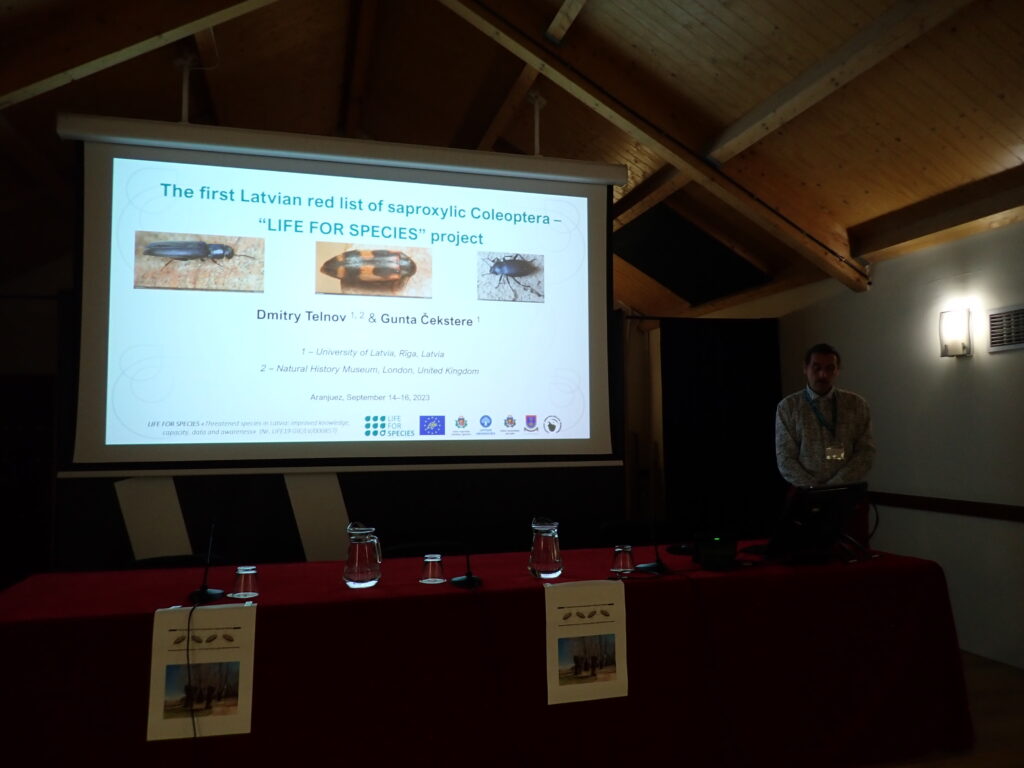
From September 4th to 8th, Jānis Bajinskis, the coordinator for the project's fish species group, represented the project at the XVII European Ichthyology Congress held in Prague, Czech Republic. The congress aimed to share knowledge among scientists from various research fields. The congress featured 9 symposiums, 7 plenary lectures by leading experts in the respective fields, 119 short oral presentations, and 93 poster reports.
During the event, Bajinskis gave an oral presentation on the contribution of the LIFE FOR SPECIES project to the protection of various endangered fish species in Latvia. The co-authors of the presentation were project manager Gunta Čekstere and marine fish species expert Jānis Gruduls.
The congress also recognized the significant role of the LIFE program in funding research and protection of endangered fish species in Europe and provided valuable advice on how to successfully apply for and implement LIFE program projects.
From September 4th to 8th, the XIX European Mycologists Congress also took place in Perugia, Italy. The project was represented by two fungi species experts, Inita Dāniele and Diāna Meiere, thanks to the financial support of the LIFE FOR SPECIES project and the Latvian National Museum of Nature.
The congress covered a wide range of topics, from fungi species protection to their use in medicine. The project experts' presentations highlighted the latest additions to the Latvian Red List of endangered fungi species, made following IUCN criteria.
Dāniele delivered an oral presentation (co-authored by Meiere) titled "The New Red List of Latvian Fungi, Based on IUCN Criteria", informing about the history of fungi species protection in Latvia and the current status. She also introduced the audience to the new Red List of fungi species developed during the "LIFE FOR SPECIES" project. Meanwhile, Meiere participated in the congress with a poster report on changes in the Latvian Red List of fungi, based on IUCN criteria, providing insights into the application of IUCN criteria for evaluating these fungi species in Latvia.
Based on feedback from all the aforementioned project experts, it can be concluded that Latvia currently lags behind other European countries in creating a Red List for species. This reinforces the relevance and significance of the LIFE FOR SPECIES project in the context of species protection measures in Latvia. In general, the importance of the LIFE programme in financing and implementing protection measures for various species and species groups is also widely recognized.
From September 12th to 14th, a networking event for Nordic and Baltic LIFE projects took place in Nuuksio National Park, Finland. Here, over 35 LIFE project teams from 6 different countries shared their experiences in implementing LIFE projects and visited various nature conservation project sites.

The first day of the networking event was spent in Nuuksio, learning about Finland's experience in implementing various LIFE projects, as well as listening to representatives from CINEA and ELMEN about the latest trends and changes in the implementation of the LIFE program.

Latvian LIFE project “Pop up” stand.
After the presentations, project teams had the opportunity to visit “Pop up” stands, where several LIFE projects engagingly introduced visitors to their areas of activity. The LIFE FOR SPECIES team from the University of Latvia’s Institute of Biology participated with their stand, implemented in collaboration with the LIFE LatViaNature integrated project and the Nature Conservation Agency's project team. At both Latvian project stands, visitors could learn about the main activities of the projects, receive educational materials, and taste various natural products from Latvia.
The second day offered excursions to three different sites: Hanko, Rekijokilaakso, and Nuuksio National Park. Each site offered a unique perspective on nature conservation efforts, from the restoration of the Hanko lagoon to the bat habitats in Rekijokilaakso. The LIFE FOR SPECIES project team visited Rekijokilaakso to observe bat-inhabited biotopes and various bat conservation measures implemented in nature. Unlike Latvia, bats are relatively common in Finland, but their population has declined over the past decades. According to the IUCN classification, they are evaluated as a “VU” or vulnerable species. Most bat habitats are outside protected natural areas, necessitating additional conservation mechanisms, including compensation mechanisms for forest owners.
The Rekijokilaakso excursion also included a representative of Finland's LIFE projects - dog trainer Tanja Karpela, who prepares dogs for work in nature conservation and participates in implementing these activities. The dog pictured is Tara (a Belgian Shepherd), who assists in species mapping processes in nature, finding bat-inhabited trees and droppings, tasks that would be much slower or impossible for experts without a dog's help. Excitingly, Latvia also has a connection with Tara and Finland, as one of Tara’s intelligent and charming offspring joined the Latvian border guard team this year!
On the final day of the networking event, all participants went to Espoo to learn about the integration of bat conservation mechanisms in an urban environment, as implemented within a LIFE project framework. For example, creating ecological corridors to connect bat-inhabited biotopes separated by major urban roads. The event concluded with a visit to the Haltia Nature Centre in Finland.
This trip was incredibly valuable, providing a platform for knowledge exchange, fostering collaboration, and deepening understanding of nuances in species conservation. Finnish project representatives particularly highlighted the importance of bat conservation and shared their experience in this field, which the LIFE For SPECIES team can consider when working on species conservation mechanisms in Latvia.
On September 29th, the annual Researchers' Night was held, featuring a range of interactive activities and lectures, including contributions from the LIFE for Species project team. The event, held at the LU Academic Center's Nature House, welcomed visitors to engage in Valdis Pilāts' informative lectures about animals listed in the Red Book, among other engaging activities.
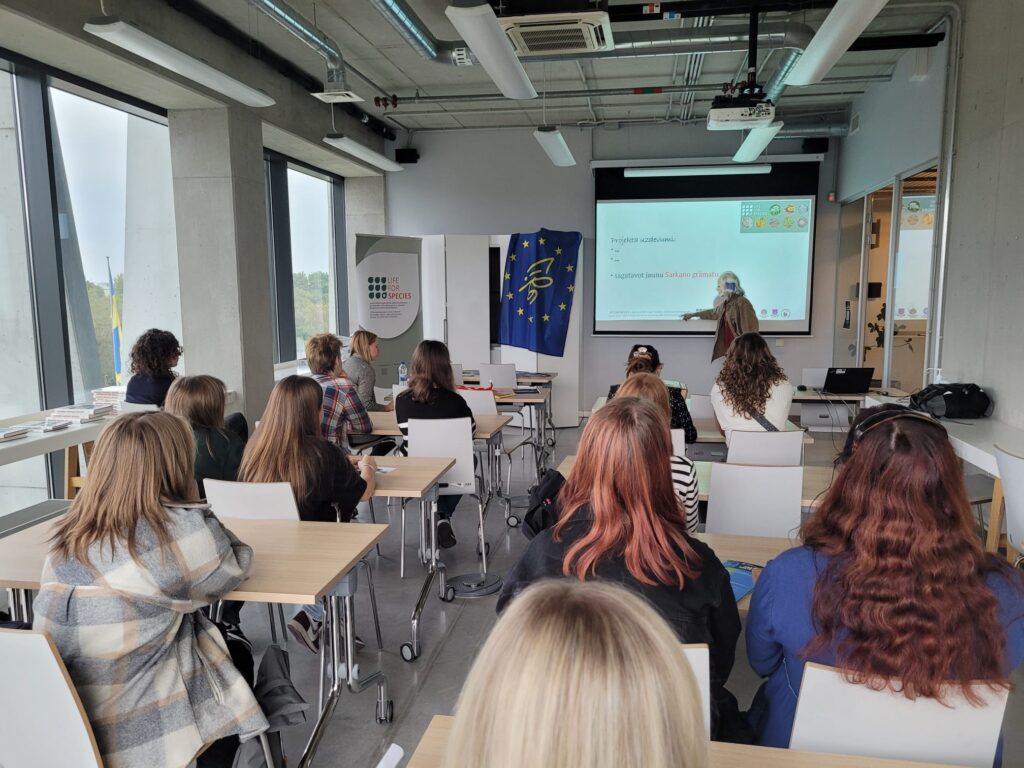
Participants had the exclusive chance to explore Latvia's first Red Book and gain insights into species protection within the country, as well as the development process of the new Red Book.
Moreover, attendees had the opportunity to test their understanding of species protection in Latvia by participating in the quiz: “How Much Do You Know About Rare and Endangered Species?”
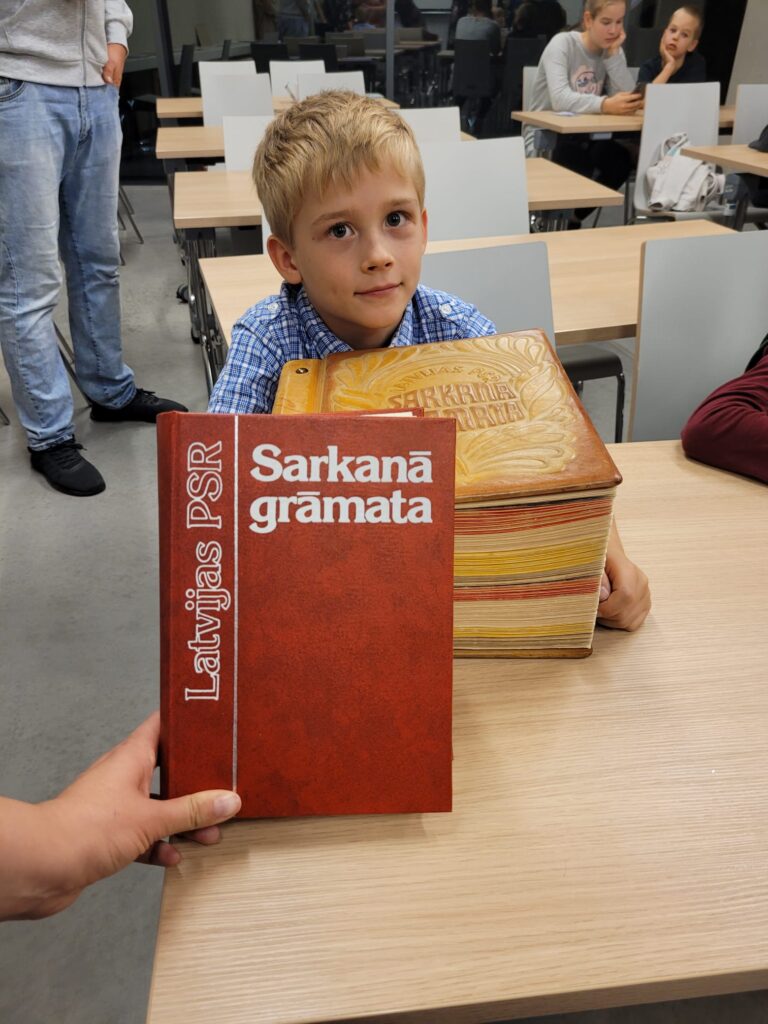
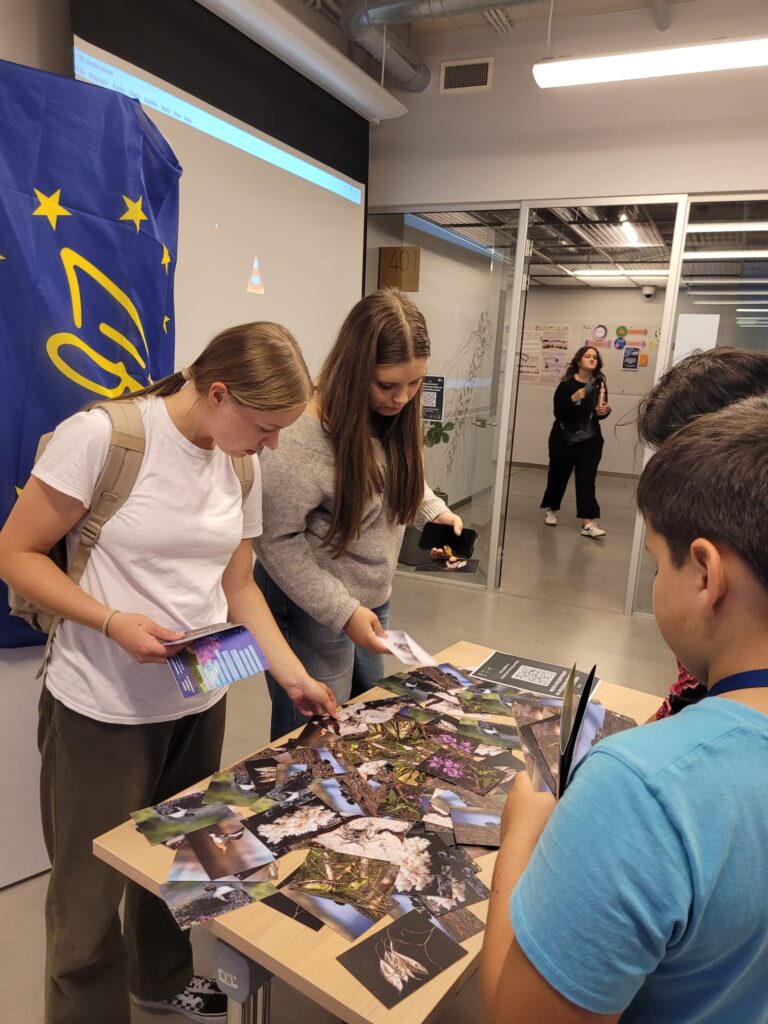
Youngest nature enthusiasts were fully engaged in crafting masks of protected species, along with activities involving coloring, gluing, and puzzle solving.
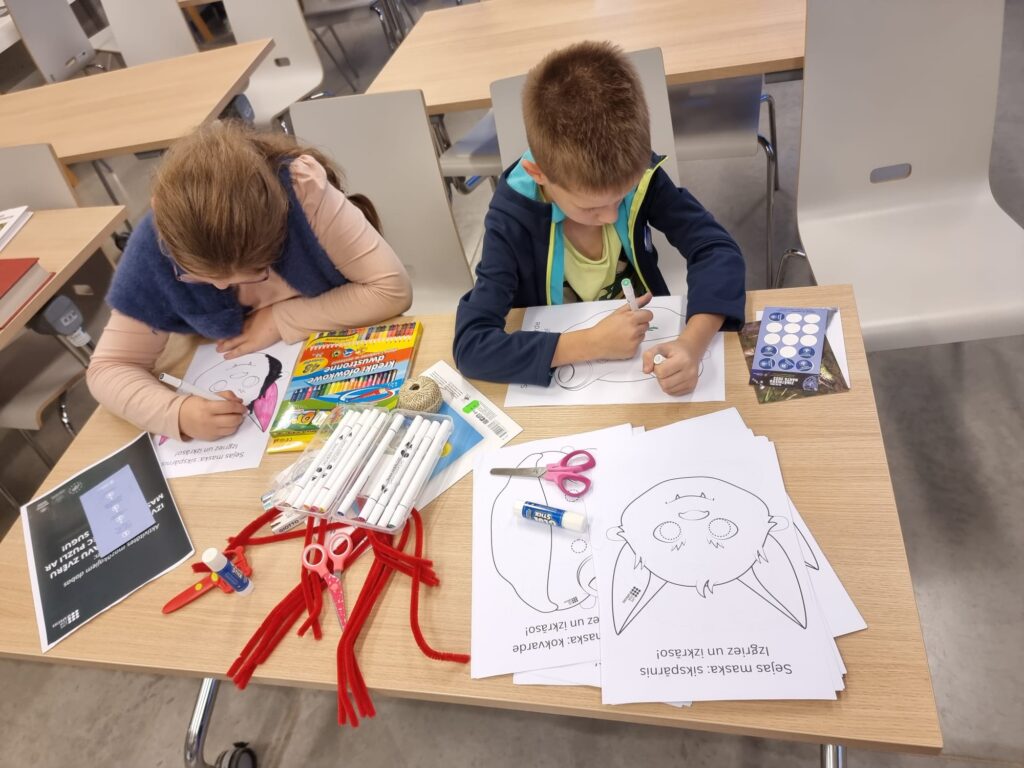
A heartfelt thank you to all those who participated.
Within the framework of the LIFE FOR SPECIES project (Endangered Species in Latvia: Improved Knowledge and Capacity, Information Flow, and Understanding), from 2021 to September 2023, proposals for a new list of protected species in Latvia have been developed.
The work was carried out as part of the project's A.1 activity "Development of Criteria for National Importance Protected Species Lists."
To introduce stakeholders to the project's proposed additions to the list of protected species for vascular plants, fungi, lichen, mosses, and mushrooms, a public meeting is planned for October 12th at 10:00 AM (on the Zoom platform).
The event program is available here.
The project's proposed additions for vascular plants, fungi, lichen, mosses, and mushrooms are available [here](link titled "Species Lists for the Meeting on 12.10.2023").
Guidelines or basic principles for criteria development and category distribution for the list of protected species are available here.
To participate in the meeting, please fill out the application by October 9th here.
A link to the meeting will be sent to the email address you provide before the meeting.
We invite stakeholders to familiarize themselves with the project's proposed additions and send comments and questions by October 9th by writing to the email madara.eihe@lu.lv.
Do you know what the sowing bird or the lark chicken is? These are ancient Latvian names for the protected species of September - the European Golden Plover (Pluvialis apricaria). We encourage you to be observant, and you might spot this species, as thousands of them are currently migrating through Latvia.
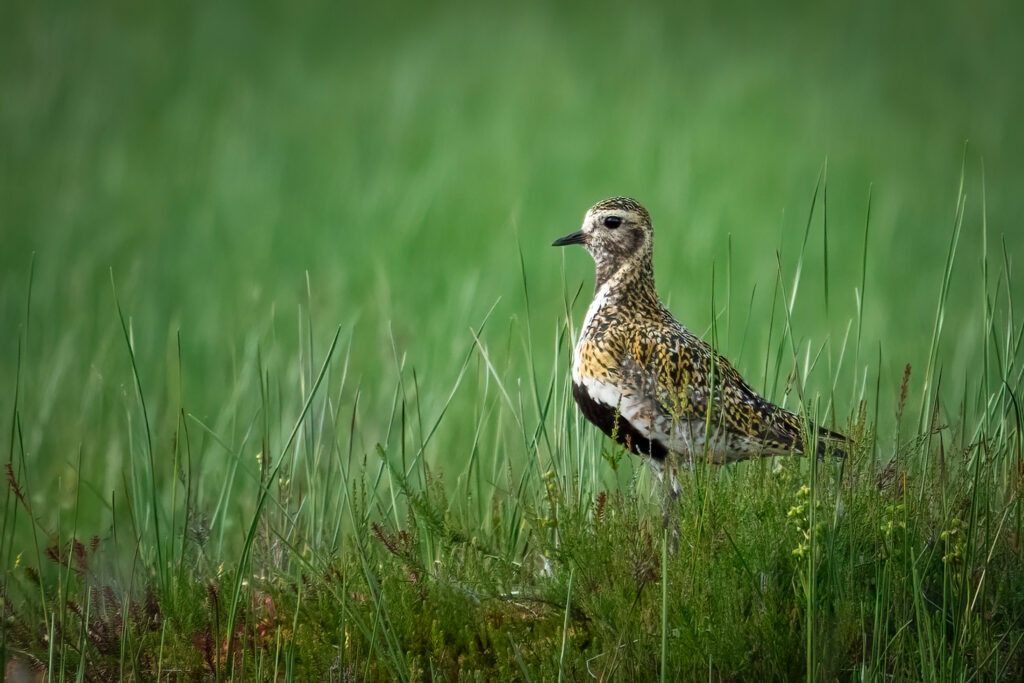
The European Golden Plover is a medium-sized bird, with a body length of 26-29 cm, a wingspan of 67–76 cm, and a weight ranging from 157 to 312 g. The average lifespan of this bird is 4 years, but it can live up to 10 years.
Adult birds in breeding plumage have a black upper body with bright yellow spots, while the lower part of the head, throat, chest, and belly are black. The undertail coverts are pale. The tail feathers are greenish-black with light cross stripes. A white stripe stretches from the base of the beak, passing through the eye and down the neck.
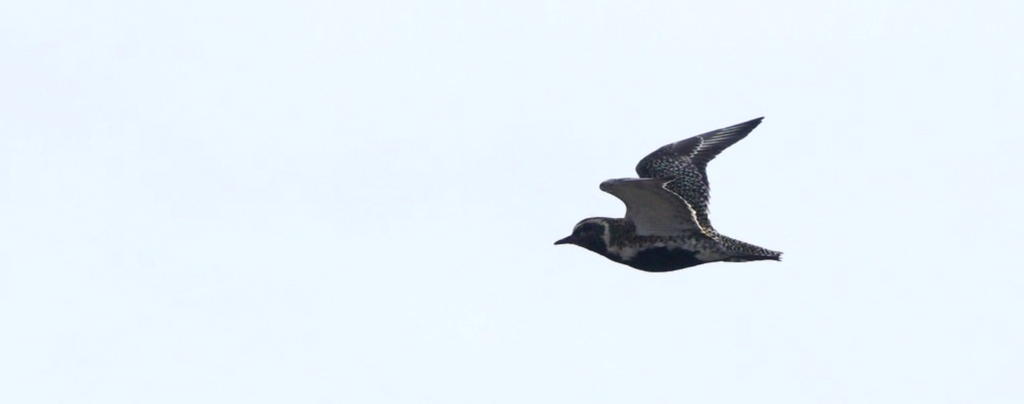
In the fall, the yellow spots are inconspicuous, and the neck is greenish-yellow with gray or black spots. Young birds have a brownish upper body with greenish-yellow spots. The beak is short and black.
The bird mainly feeds on insects, such as beetles and caterpillars. However, its diet can also include other invertebrates, seeds, berries, and even worms. The European Golden Plover often searches for food at night.
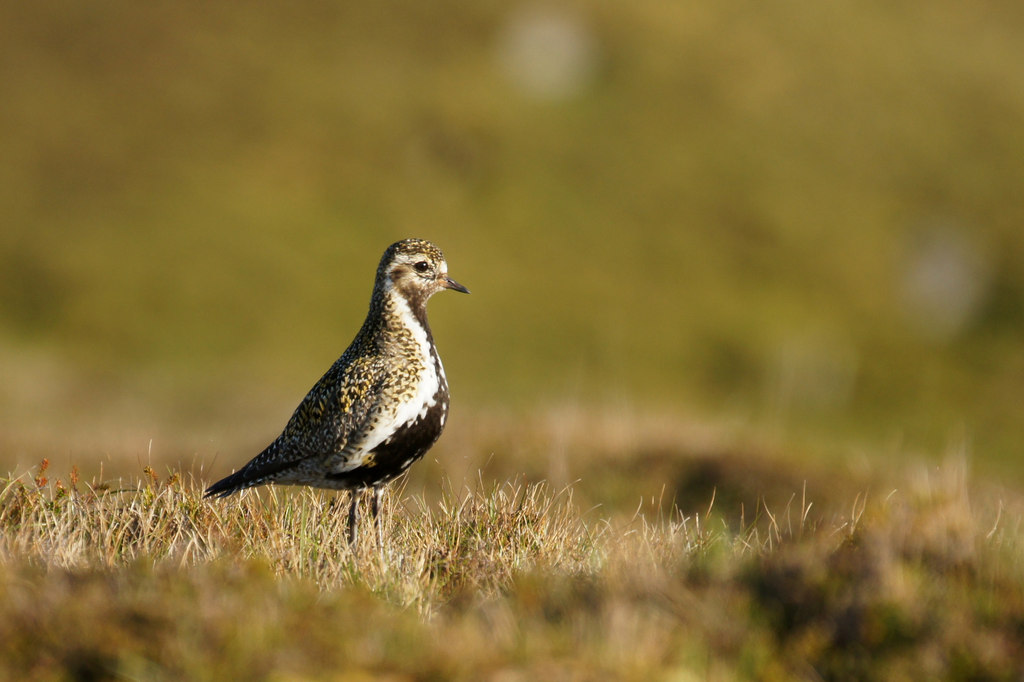
European Golden Plovers form monogamous pairs that stay together for life. Each breeding season, they produce only one brood. Although they usually nest separately, their nests can sometimes be found less than 100m apart.
Each pair is closely attached to a specific nesting site and defends it from other birds, but they often search for food outside their nesting territory.
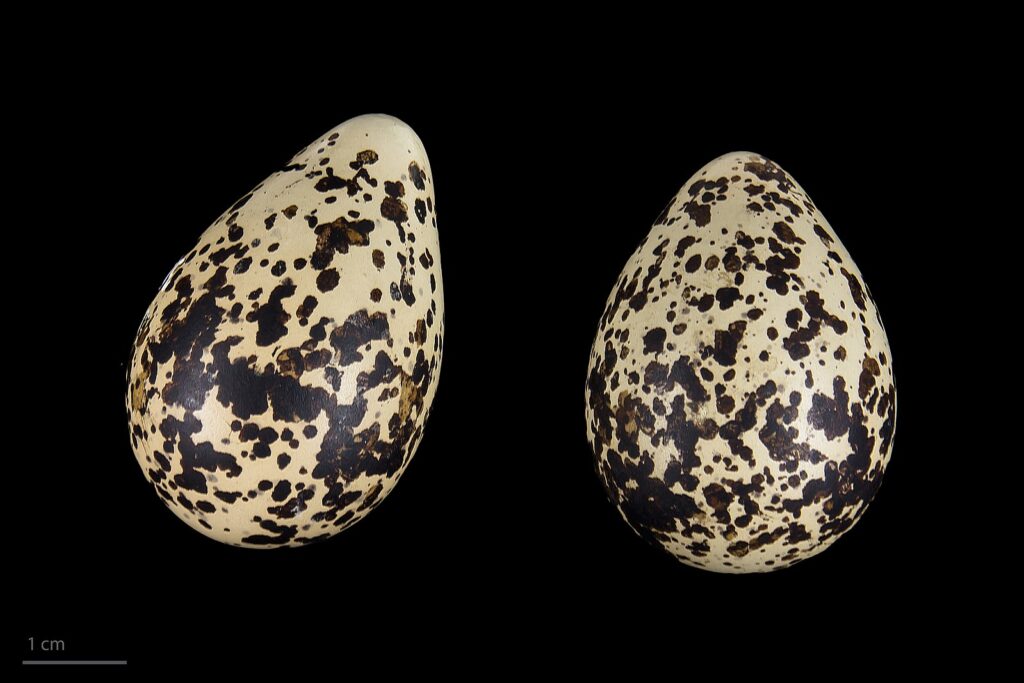
The nest of the European Golden Plover is a shallow depression in the ground, lined with moss and various other plants. Each clutch contains 2-5 eggs, recognizable by their light brown color adorned with black spots.
The incubation period for the eggs lasts from 28 to 31 days, and both parents care for both the eggs and the hatched chicks. The chicks are precocial and soon after hatching, they actively follow their parents and start searching for food on their own. Their feathers fully develop at the age of 25-33 days, and soon after, the chicks become independent. European Golden Plovers reach sexual maturity at the age of 2.
The European Golden Plover is a migratory bird that winters in Western Europe and the Mediterranean region. A small number also winter in Latvia. They typically winter in agricultural fields, freshwater pond shores, and wet meadows. The species' breeding range extends from Greenland across the northern part of Europe to the northern parts of Siberia. Latvia's breeding population consists of 260–550 pairs.
Within the framework of the LIFE FOR SPECIES project (Endangered Species in Latvia: Improved Knowledge and Capacity, Information Flow, and Understanding), from 2021 to September 2023, proposals for a new list of protected species in Latvia has been developed.
The work was carried out as part of the project's A.1 activity "Development of Criteria for National Importance Protected Species Lists."
To introduce stakeholders to the project's proposed additions to the list of protected species for birds, mammals, invertebrates, amphibians, reptiles, and fish, a public meeting is planned for October 11th at 10:00 AM (on Zoom platform).
The event program is available here.
The project's proposed additions for birds, mammals, invertebrates, amphibians, reptiles, and fish are available [here].
Guidelines or basic principles for criteria development and category distribution for the list of protected species are available here.
To participate in the meeting, please fill out the application by October 8th here.
A link to the meeting will be sent to the email address you provide before the meeting.
We invite stakeholders to familiarize themselves with the project's proposed additions and send comments and questions by October 5th by writing to the email madara.eihe@lu.lv.
Additional information: second meeting about the project's proposed additions to the list of protected species for vascular plants, fungi, lichen, mosses, and mushrooms will be organized on October 12th, 2023 (on the Zoom platform). More information will be sent out in the coming days.
Within the framework of the LIFE FOR SPECIES project (Endangered Species in Latvia: Improved Knowledge and Capacity, Information Flow, and Understanding), from 2021 to July 2023, an evaluation of the endangered species of fish and determination of their extinction risk level was conducted. This was done using the methodology and criteria developed by the International Union for Conservation of Nature (IUCN, https://www.iucnredlist.org/; a summary in Latvian is available here). The work was carried out as part of the project's B.1 activity "Re-evaluation of species protection status and preparation of the endangered species list using IUCN criteria."
To introduce stakeholders to the results of the fish species evaluation, a public meeting is planned for August 31st at 10:00 AM (on Zoom platform).
The agenda includes:
The expected duration of the meeting is up to two hours.
To participate in the meeting, please fill out the application by August 29th here.
A link to the meeting will be sent to the email address you provide before the meeting.
51 fish species were selected and evaluated in the project. The results are available here.
We invite stakeholders to familiarize themselves with the results of the fish species evaluation and send comments and questions before the meeting by writing to the email madara.eihe@lu.lv.
As autumn approaches, we increasingly venture into the forest in search of one of nature's treasures dear to Latvians - mushrooms. We urge mushroom pickers to be cautious and keep an eye out for this month's protected species - the Wrinkled Peach (Rhodotus palmatus).

Foto: Stu's Images
The Wrinkled Peach stands out for its colour, with the mushroom's hue ranging from pale pink to apricot-red, featuring a translucent, slimy, and wrinkled surface. The flesh of the mushroom has a fruity aroma and a bitter taste, making it inedible (also due to its rubbery texture).

Foto: Stu's Images
The gills of the mushroom are initially white, turning pink later on, and are sparse and free. The stem is typically 2-5 cm long and 0.5-1.5 cm thick, matching the cap's colour and having a silky fibrous texture. The spores are ferruginous, almost round, and colourless.

Map by Jānis Ukass.
In Latvia, this beautiful species is rare, mostly found in deciduous forests on beech or alder wood, either singly or in clusters. They can also be spotted in sawmills and on stacks of logs intended for transport by the roadside. Almost all of the sightings of this mushroom in Latvia have so far been in the Gauja National Park.

Foto: Dan Molter
Any forest walker who carefully observes their surroundings and occasionally looks upward won't miss this brightly pink mushroom with its wrinkled, slimy surface. In online images, sometimes its wrinkled texture is very pronounced and the colour very vivid – however, the specimens found in Latvia so far haven't been as vibrant. In English, this mushroom is called the "Wrinkled Peach," which aptly describes its appearance.
Within the framework of the LIFE FOR SPECIES project (Endangered Species in Latvia: Improved Knowledge and Capacity, Information Flow, and Understanding), an evaluation of the endangered species of linchen and determination of their extinction risk level was conducted from 2021 to July 2023. This was done using the methodology and criteria developed by the International Union for Conservation of Nature (IUCN, https://www.iucnredlist.org/; a summary in Latvian is available here). The work was carried out as part of the project's B.1 activity "Re-evaluation of species protection status and preparation of the endangered species list using IUCN criteria."
To introduce stakeholders to the provisional results of the linchen species evaluation, a public meeting is planned for August 17th at 10:00 AM (on the Zoom platform).
The agenda includes:
The expected duration of the meeting is up to two hours.
To participate in the meeting, please fill out the application by August 15th here.
A link to the meeting will be sent to the email address you provide before the meeting.
More than 80 linchen species were selected and evaluated in the project. The results are available here.
We invite stakeholders to familiarize themselves with the results of the linchen species evaluation.